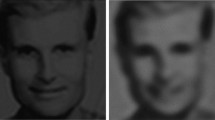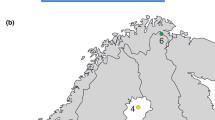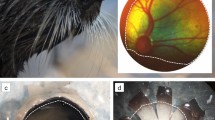Summary
The relationships between habitat depth, eye diameter relative to body length, and the dimensions of rhabdoms and crystalline cones have been examined for 13 species of three oceanic euphausiid genera with habitats ranging from near-surface waters to the deep-sea. Rate of eye growth decreases with depth. Longer rhabdoms may increase the visual sensitivity to point and extended light sources by an eye of a particular size with depth. Larger interommatidial angles suggest that visual acuity decreases at depth. Depth-related changes in euphausiid eyes are considered with respect to the probable roles of vision and bioluminescence in the deep-sea. Unusual features of the eyes of several species are described.
Similar content being viewed by others
References
Baguet F, Piccard J, Christophe B, Marechal G (1983) Bioluminescence and luminescent fish in the Strait of Messina from the Mesoscaph ‘Forel’. Mar Biol 74:221–229
Ball EE (1977) Fine structure of the compound eyes of the midwater amphipodPhronima in relation to behavior and habitat. Tissue Cell 9:521–536
Beddard FE (1886) Report on the isopoda collected by the HMS Challenger during the years 1872–1876. Challenger Report, vol 17
Beddard FE (1890) On the minute structure of the eye in some shallow-water and deep-sea species of the isopod genusActurus. Proc Zool Soc London 26:365–375
Brinton E (1962) The distribution of Pacific euphausiids. Bull Scripps Inst Oceanogr 8:51–270
Brinton E (1967) Vertical migration and avoidance capability of euphausiids in the California Current. Limnol Oceanogr 12:451–483
Brinton E (1975) Euphausiids of southeast Asian waters. Naga Report, vol 4, Part 5. University of California, Scripps Institution of Oceanography, La Jolla, California
Brinton E (1979) Parameters relating to the distributions of planktonic organisms, especially euphausiids in the eastern tropical Pacific. Prog Oceanogr 8:125–189
Brinton E, Wyllie JG (1976) Distributional atlas of euphausiid growth stages off southern California. CALCOFI Atlas no. 24. 289 pp
Bruno MS, Barnes SN, Goldsmith RH (1977) The visual pigment and visual cycle of the lobsterHomarus. J Comp Physiol 120:123–142
Chun C (1896) Atlantis Biologische Studien über pelagische Organismen. Zoologica Stuttgart 7:1–260
Clarke GL, GK Wertheim (1956) Measurements of illumination at great depths and at night in the Atlantic Ocean by means of a new bathyphotometer. Deep-Sea Res 3:189–205
Denys CJ, Adamian M, Brown PK (1983) Ultrastructure of the eye of a euphausiid crustacean. Tissue Cell 15:77–95
Goldsmith TH, Wehner R (1977) Restrictions on rotational and translational diffusion of pigment in the membranes of a rhabdomeric photoreceptor. J Gen Physiol 70:453–490
Gopalakrishnan K (1973) Biology and zoogeography of the genusNematoscelis (Crustacea, Euphausiacea). PhD thesis, University of California, San Diego
Hallberg E (1977) The fine structure of the compound eyes of mysids (Crustacea:Mysidacea). Cell Tissue Res 184:45–65
Hanström B (1932) Neue Untersuchungen über Sinnesorgane und Nervensystem der Crustaceen. II. Zool Jahrb Anat 56:387–520
Herring PJ, Locket NA (1978) The luminescence and phosphores of euphausiid crustaceans. J Zool 186:431–462
Kampa E (1965) The euphausiid eye — a re-evaluation. Vision Res 5:475–481
Kampa EM (1970) Underwater daylight and moonlight measurements in the eastern North Atlantic. J Mar Biol Assa UK 50:397–420
Kirschfeld K (1974) The absolute sensitivity of lens and compound eyes. Z Naturforsch 29C:592–596
Kirschfeld K (1976) The resolution of lens and compound eyes. In: Zettler F, Weiler R (eds) Neural principles in vision. Springer, Berlin Heidelberg New York, pp 354–370
Land MF (1979) Optics and vision in invertebrates. In: Autrum H (ed) Handbook of sensory physiology, vol VII/6B. Springer, Berlin Heidelberg New York, pp 471–592
Land MF (1981) Optics of the eyes ofPhronima and other deep-sea amphipods. J Comp Physiol 145:209–226
Land MF, Burton FA (1979) The refractive index gradient in the crystalline cones of the eyes of an euphausiid crustacean. J Exp Biol 82:395–398
Land MF, Burton FA, Meyer-Rochow VB (1979) The optical geometry of euphausiid eyes. J Comp Physiol 130:49–62
Marshall NB (1971) Explorations in the life of fishes. Harvard University Press, Cambridge MA
Mauchline J, Fisher LR (1969) The biology of euphausiids. Russell FS, Yonge M (eds) Advanced marine biology, vol 7. Academic Press, London
Meyer-Rochow VB (1978) The eyes of mesopelagic crustaceans. II.Streetsia challengeri (Amphipoda). Cell Tissue Res 186:337–349
Meyer-Rochow VB, Walsh S (1977) The eyes of mesopelagic crustaceans: I.Gennadus sp. (Penaeidae). Cell Tissue Res 184:87–101
Meyer-Rochow VB, Walsh S (1978) The eyes of mesopelagic crustaceans. III.Thysanopoda tricuspidata (Euphausiacea). Cell Tissue Res 195:59–79
Nemoto T (1966)Thysanoessa euphausiids, comparative morphology, allomorphosis and ecology. Whales Res Instit Tokyo Sci Rep 20:109–155
Roger C (1974) Répartitions bathymétriques et migrations verticales des euphausiacés (Crustacés) dans les zones de pêche au thon du Pacifique sud-tropical. Cahiers ORSTOM, Série Océanographie 12:221–239
Smith SI (1886) The abyssal decapod Crustacea of the ‘Albatross’ dredgings in the North Atlantic. Ann Mag Nat Hist Ser 5, 17:187–198
Smith SI (1890) On the minute structure of the eye in some shallow-water and deep-sea species of the isopod genusArcturus. Proc Zool Soc London 26:365–375
Warner JA, Latz MI, Case JF (1979) Cryptic bioluminescence in a midwater shrimp. Science 203:1109–1110
Welsh JH, Chace FA (1937) Eyes of deep-sea crustaceans. I. Acanthephyridae. Biol Bull 72:57–74
Welsh JH, Chace FA (1938) Eyes of deep-sea crustaceans. II. Sergestidae. Biol Bull 74:364–375
Zharkova IS (1970) Reduction of the organs of vision in deep- sea mysids. Zool Zh 49:685–693
Zharkova IS (1973) Histological structure of the eye in three representatives ofMunidopsis (Crustacea, Decapoda). Zool Zh 52:1643–1647
Zharkova IS (1975) Reduction of organs of sight in deep-water Isopoda, Amphipoda and Decapoda. Zool Zh 54:200–208
Author information
Authors and Affiliations
Rights and permissions
About this article
Cite this article
Hiller-Adams, P., Case, J.F. Optical parameters of euphausiid eyes as a function of habitat depth. J. Comp. Physiol. 154, 307–318 (1984). https://doi.org/10.1007/BF00605230
Accepted:
Issue Date:
DOI: https://doi.org/10.1007/BF00605230




